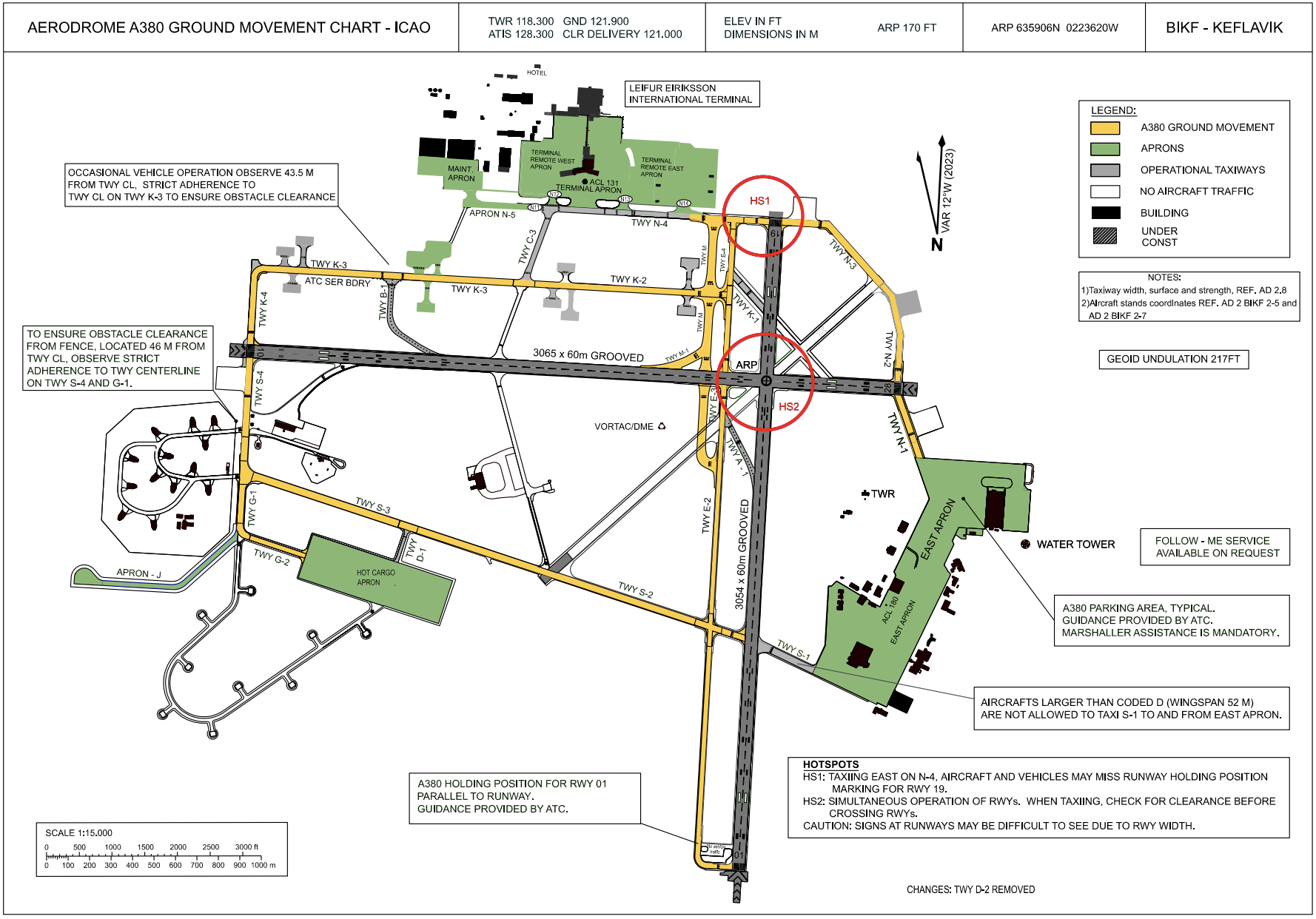Ground
Keflavik Ground (BIKF_GND, as well as BIKF_2_GND if online) is responsible for controlling the aprons and taxiways at BIKF.
Parking Locations
|
Flight Type |
Parking Location |
|
Scheduled Passenger (Schengen Area) |
- Stands 1-6 (Terminal Apron) |
|
Scheduled Passenger (Other) |
- Stands 7-14 (Terminal Apron)* - Terminal Remote East Apron |
|
Cargo |
- Terminal Remote West Apron - East Apron |
|
General Aviation |
- East Apron |
Note:
- Aircraft larger than Class D with wingspan of 171’/52m or more are not allowed to taxi via S1 to and from the East Apron, and south of stand 111 on the East Apron.
- Aircraft parked on stands 11 & 14 must push back onto taxiway N.
- De-icing, if required, takes place on stand.
- There is a run-up area on a pad connected to taxiway N3/N2.
- There is a run-up area on a pad connected to taxiway N3/N2.
Terminal Apron
As the Terminal Apron features some unique procedures, the following section is dedicated to them.
Entry Points
There are three entry points into the Terminal Apron – N12, N13, and N14. For aircraft entering the Terminal Apron, GND should specify which entry point the aircraft should leave or enter the apron from – e.g., “taxi via N12, N…”
Departing aircraft leaving the apron may be instructed to hold short of N12/13/14 if N itself is occupied by other taxiing traffic. Similarly, arriving aircraft may be instructed to give way to aircraft entering N from N12/13/14.
Tug Release Points
There are tug release points on the Terminal (North) Apron. While their use is standard IRL, due to limitations of some simulator software and the availability of addons, on VATSIM they are only used/assigned on pilot request.
|
Stand No. |
Standard Release Point |
Overflow Release Point |
Stand No. |
Standard Release Point |
Overflow Release Point |
|
1, 3, 5, 7, 46 |
9 |
10 |
12, 77 |
7 |
5, 6 |
|
9, 40, 42, 44 |
10 |
9, 11 |
76, 78 |
4 |
3, 2 |
|
11, 14 |
8 |
11 |
74 |
3 |
2, 4 |
|
2, 4, 6, 8 |
5 |
4, 6 |
70, 71, 72, 73 |
1 |
2 |
|
62, 63, 65 |
12 |
11 |
75 |
2 |
1 |
|
10, 79 |
6 |
5, 7 |
55, 57, 59, 61 |
13 |
— |
Aircraft must not be cleared to push to a tug release point that is occupied. If the standard release point is occupied, GND should utilize the overflow release points in the order listed above.
If a pilot is pushing to the standard release point designated for their stand, then GND does not have to state the tug release point in the push & start clearance. However, if they are pushing to an overflow release point, or if the pilot asks which release point they should use, then GND may state the release point in the pushback clearance. For example:
🎧 ICE502, push & start approved, stand 2, release point 5, QNH 1024.
A380 Ground Movement
Due to the massive size & wingspan of A380s, specific taxiways have been designated for A380 ground movement.
A380s may only be taxied on the yellow taxiways marked above, and should only be parked at the A380 parking area on the East Apron (stand 120.) A380s are also expected to use the A380 holding position for RWY 01, parallel to the typical E1 holding point for RWY 01 (see bottom of the chart).
Controllers may also consider strategically taxiing or backtracking aircraft via the runways to shorten A380s’ taxi distance.
Secondary GND Position
BIKF has an overflow aerodrome frequency, which for VATSIM purposes has the login callsign BIKF_2_GND.
BIKF_2_GND may relieve any of the usual responsibilities of either BIKF_GND or BIKF_TWR. BIKF_2_GND may only be opened with the approval of the existing BIKF_GND (if performing Ground responsibilities) or BIKF_TWR (if performing Tower responsibilities) controllers.
BIKF_2_GND may adopt the callsign “Keflavik Ground” or “Keflavik Tower,” depending on whether it is performing Ground or Tower responsibilities.


